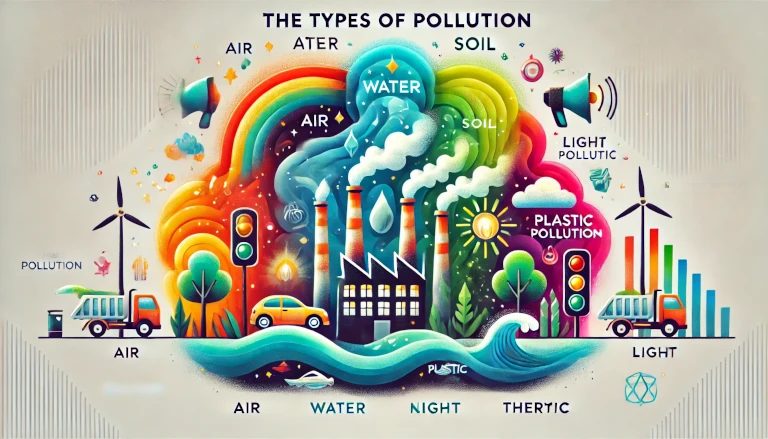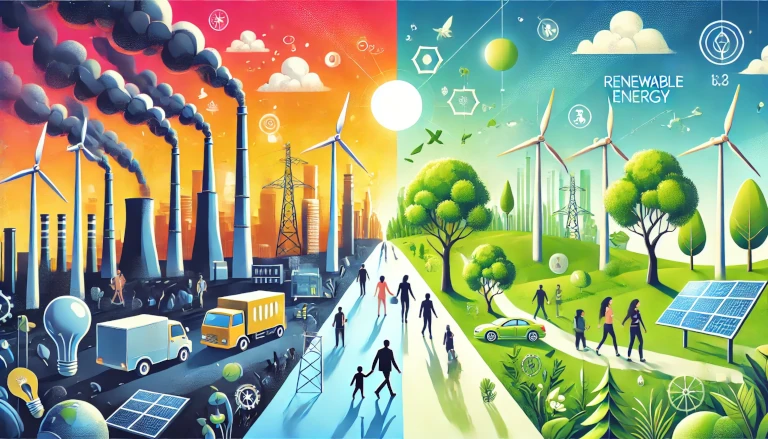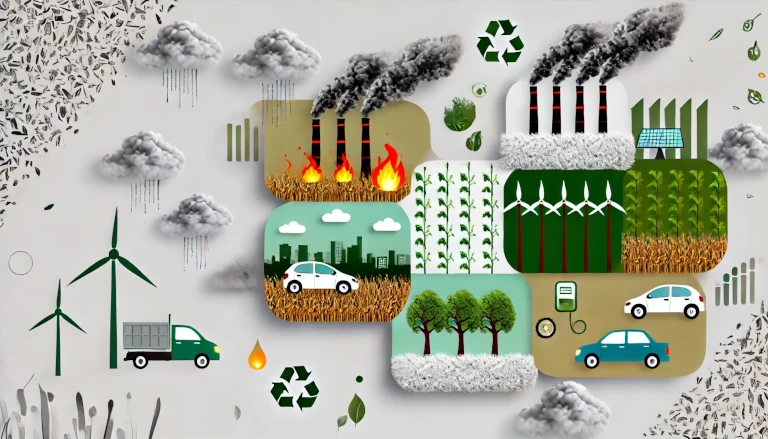Pollution is one of the most significant environmental issues facing the world today. It occurs when harmful substances contaminate the environment, causing adverse effects on ecosystems, human health, and the planet as a whole. There are various types of pollution, each having its specific sources and impacts. In this blog post, we will explain the most common types of pollution and provide examples to help you understand their effects.
1. Air Pollution
Air pollution occurs when harmful gases, chemicals, or particulates are released into the atmosphere. These pollutants come from various sources, including vehicles, industries, and natural events like wildfires or volcanic eruptions. Air pollution can lead to severe health problems like asthma, lung cancer, and heart diseases.
Examples:
- Vehicle emissions: Cars and trucks emit carbon monoxide and nitrogen oxides, contributing to poor air quality and smog in urban areas.
- Industrial emissions: Factories release pollutants like sulfur dioxide and carbon dioxide, contributing to global warming and acid rain.
Real-life example:
In cities like New Delhi, India, and Beijing, China, air pollution levels often rise so high that residents are advised to stay indoors. These cities are frequently covered in a thick layer of smog due to heavy traffic and industrial activity, significantly affecting air quality.
2. Water Pollution
Water pollution happens when harmful substances like chemicals, plastics, and waste materials contaminate water bodies such as rivers, lakes, and oceans. This type of pollution poses a serious threat to aquatic ecosystems, wildlife, and human health.
Examples:
- Chemical runoff: Pesticides and fertilizers used in agriculture often run off into nearby water bodies, harming aquatic life.
- Plastic waste: Non-biodegradable plastics, such as water bottles, accumulate in oceans, forming large garbage patches like the Great Pacific Garbage Patch.
Real-life example:
The Flint water crisis in Michigan, USA, is a well-known example of water pollution, where lead-contaminated water caused severe health problems for thousands of residents due to improper water treatment.
3. Soil Pollution
Soil pollution occurs when harmful chemicals, waste products, or other pollutants are introduced into the soil, negatively affecting plant growth and contaminating food sources. This type of pollution can arise from industrial activities, agricultural practices, and improper waste disposal.
Examples:
- Pesticides: The overuse of chemical pesticides in farming degrades soil quality and harms microorganisms that are essential for healthy soil.
- Industrial waste: Factories that dump hazardous chemicals into the soil can lead to long-term contamination, making the land unusable for agriculture.
Real-life example:
The Love Canal incident in New York, where toxic chemical waste buried by a chemical company leaked into nearby residential areas, led to severe soil contamination and health problems among the local population.
4. Noise Pollution
Noise pollution refers to the excessive or harmful levels of noise in the environment, which can cause discomfort and health issues for both humans and animals. Common sources of noise pollution include traffic, construction activities, and industrial operations.
Examples:
- Traffic noise: Busy highways and streets in cities generate constant noise, disturbing nearby residents.
- Construction sites: Ongoing construction projects in urban areas can result in high levels of noise pollution, affecting workers and nearby communities.
Real-life example:
In many urban areas, residents living near airports suffer from noise pollution caused by constant airplane take-offs and landings. Studies show that prolonged exposure to such noise can lead to sleep disturbances and elevated stress levels.
5. Light Pollution
Light pollution is the excessive or misdirected artificial light that brightens the night sky and disrupts ecosystems. It mainly affects urban areas, where streetlights, buildings, and outdoor lighting create a glowing sky, making it difficult to observe stars and natural nighttime beauty.
Examples:
- Street lighting: Bright streetlights in cities contribute to light pollution, affecting nocturnal animals and disturbing natural patterns like sleep cycles in humans.
- Billboards and advertisements: Brightly lit billboards and digital advertisements increase light pollution, especially in commercial areas.
Real-life example:
In highly urbanized areas like New York City or Tokyo, light pollution is so prevalent that it’s nearly impossible to see stars in the night sky. This artificial brightness also disrupts the natural rhythms of wildlife, including birds and insects.
6. Thermal Pollution
Thermal pollution occurs when human activities raise the temperature of natural water bodies, leading to negative effects on aquatic ecosystems. This type of pollution typically comes from industrial plants that use water for cooling and then discharge the heated water back into the environment.
Examples:
- Power plants: Nuclear and coal power plants release heated water into rivers and lakes, which can disrupt the local ecosystem and reduce oxygen levels in the water.
- Industrial cooling systems: Factories that rely on water for cooling machinery often discharge warm water, altering the temperature of nearby water bodies.
Real-life example:
Thermal pollution from a power plant on the Rhine River in Europe caused a significant increase in water temperatures, affecting fish populations and other aquatic organisms that could not survive in the warmer environment.
7. Plastic Pollution
Plastic pollution is one of the fastest-growing environmental issues, caused by the overuse of plastic products that are not biodegradable. This pollution affects land and water ecosystems, endangering wildlife and contaminating food chains.
Examples:
- Plastic bags: Single-use plastic bags that end up in landfills or oceans can take hundreds of years to degrade and pose a threat to animals that mistakenly consume them.
- Microplastics: Tiny plastic particles, often found in cosmetics and clothing, pollute water bodies and have been found in marine animals, even entering the human food chain.
Real-life example:
The Great Pacific Garbage Patch, located in the Pacific Ocean, is a massive accumulation of plastic waste, stretching over 1.6 million square kilometers, posing a severe threat to marine life and the ecosystem.
Pollution comes in many forms, including air, water, soil, noise, light, thermal, and plastic pollution. Each type has its own set of causes and harmful effects, but with increased awareness and responsible actions, we can reduce pollution and protect our environment. Whether it’s reducing vehicle emissions, recycling plastic waste, or using eco-friendly products, every small effort counts in the fight against pollution.
Read this in Marathi at वेगवेगळ्या प्रकारच्या प्रदूषणांची ओळख आणि त्यांचे परिणाम – प्रत्यक्ष उदाहरणांसह
Discover more from Green Ecosystem - Renewable Energy, Agriculture, and Environmental Sustainability
Subscribe to get the latest posts sent to your email.


